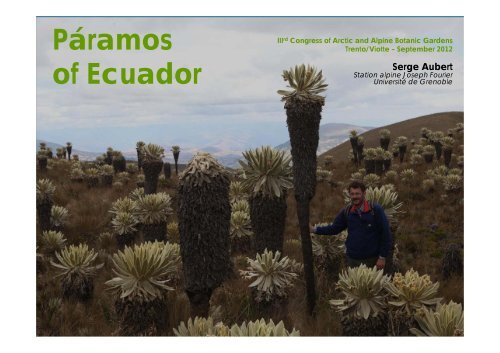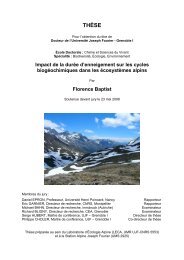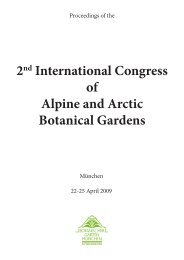Growth form - Station Alpine Joseph Fourier
Growth form - Station Alpine Joseph Fourier
Growth form - Station Alpine Joseph Fourier
You also want an ePaper? Increase the reach of your titles
YUMPU automatically turns print PDFs into web optimized ePapers that Google loves.
Páramos<br />
of Ecuador<br />
III rd Congress of Arctic and <strong>Alpine</strong> Botanic Gardens<br />
Trento/Viotte – September 2012<br />
Serge Aubert<br />
<strong>Station</strong> alpine <strong>Joseph</strong> <strong>Fourier</strong><br />
Université de Grenoble
Geography
(mega)Biodiversity<br />
• one of 17 countries in the world which are classified as megadiverse by the group<br />
Conservation International<br />
• more than 1600 bird species, 350 species of reptiles, 400 species of amphibians, 324<br />
species of mammals<br />
• around 15900 species of plants (including ca 4000 orchids), around 4173 of which<br />
are endemic
Alexander von Humboldt (1769-1859) &<br />
Aimé Bonpland (1773-1858)<br />
(par Eduard Ender, ca. 1850)<br />
Humboldt and the biogeography<br />
Mount Chimborazo : 6267 m (DR)
Humboldt and the biogeography<br />
Physical Geography. Humboldt’s Distribution of Plants in<br />
Equinoctial America, According to Elevation Above the Level<br />
of the Sea (1839)<br />
“Outlines of Botanical Geography” and “The Geographical<br />
Distribution of Plants”. From Johnston’s The Physical Atlas<br />
(1849) On this sheet, Johnston incorporated and expanded<br />
data from both Humboldt and Berghaus.
Vegetation
Distribution and climate of páramos<br />
Luteyn 1999 in Sklenar et al 2011 Bot Rev 77:71–108<br />
Hammen & Cleef, 1986 in Sklenar et al 2011 Bot Rev 77:71–108<br />
Luteyn 1999 Páramos: A Checklist of<br />
Plant Diversity, Geographical<br />
Distribution, and Botanical Literature<br />
Venezuelan páramos with Coespeletia<br />
timotensis (photo A. Gröger)<br />
Rundel & al 1994 Tropical <strong>Alpine</strong> Environments:<br />
Plant Form and Function<br />
Lachemilla orbiculata (Rosaceae, N)<br />
páramo del Angel 3500 m – 6 am
Treeline and páramos
The treeline: Polylepis div sp (Rosaceae)<br />
Polylepis sp (N)<br />
Polylepis incana (N)<br />
Oncidium cucullatum (N) Epidendrum tenuicaule (N) Polylepis racemosa (N)
Bosque siempreverde montano alto
TROPICAL Endemic<br />
(E: 17)<br />
Plant diversity and distribution of genera<br />
Neotropical<br />
(N: 242)<br />
Wide<br />
Tropical<br />
(WT: 58)<br />
TEMPERATE Austral-<br />
Antarctic<br />
(AA: 34)<br />
Holarctic (H:<br />
41)<br />
Wide<br />
temperate<br />
(WTe: 76)<br />
COSMOPOLITAN Worldwide, or<br />
nearly so,<br />
Distribution<br />
(C: 41)<br />
Confined (almost)<br />
exclusively to<br />
páramo<br />
from lowlands to the<br />
alpine zone, also<br />
outside páramo<br />
Widely distributed in<br />
tropical America,<br />
occurring also in the<br />
Palaeotropics<br />
South temperate<br />
distribution<br />
North temperate and<br />
mediterranean<br />
distribution<br />
Temperate and cool<br />
regions of<br />
both hemispheres<br />
TOTAL = 509 genera / 127 families / 3500 species<br />
Aragoa, Ascidiogyne, Blakiella, Bucquetia, Castratella, Cotopaxia, Espeletia, Floscaldasia,<br />
Hinterhubera,Laestadia, Myrrhidendron, Nephropteris, Neurolepis, Perissocoeleum, Plutarchia,<br />
Raouliopsis, Westoniella<br />
Arcytophyllum, Baccharis, Cavendishia, Ceratostema, Chuquiraga, Chusquea,<br />
Diplostephium, Disterigma, Distichia, Dorobea, Epidendrum, Gynoxys, Halenia, Lachemilla,<br />
Lasiocephalus, Loricaria,Jamesonia, Monnina, Nototriche, Odontoglossum, Oncidium, Opuntia,<br />
Oreopanax, Pentacalia, Perezia, Polylepis, Puya, Werneria, Xenophyllum, etc.<br />
Achyrocline, Begonia, Bothriochloa, Buddleja, Bulbostylis, Cheilanthes, Clethra, Conyza, Cyperus,<br />
Dicksonia, Dioscorea, Elaphoglossum, Eragrostis, Eriocaulon, Grammitis, Hedyosmum,<br />
Hymenophyllum, Hypoxis, Ilex, Maytenus, Myrsine, Ocotea, Paspalum, Passiflora, Peperomia,<br />
Persea, Pilea, Piper, Phytolacca, Pteris, Schefflera, Sporobolus, Tournefortia, Xyris, etc.<br />
Acaena, Azorella, Calandrinia, Calceolaria, Colobanthus, Cortaderia, Cotula, Desfontainia,<br />
Drimys, Dysopsis, Escallonia, Fuchsia, Gaultheria, Gunnera, Libertia, Lilaea, Lilaeopsis,<br />
Lomatia, Muehlenbeckia, Myriactis, Myrteola, Nertera, Oreobolus, Oreocallis, Oreomyrrhis,<br />
Orthrosanthus,Ourisia, Pernettya, Prumnopitys,Rostkovia, Tristerix, Ugni, Uncinia, Weinmannia<br />
Antennaria, Astragalus, Bartsia, Berberis, Castilleja, Cerastium, Cirsium, Draba, Erigeron,<br />
Erysimum, Geum, Helianthemum, Hypochaeris, Lathyrus, Lithospermum, Lupinus, Muhlenbergia,<br />
Oenothera, Parietaria, Pedicularis, Phacelia, Potentilla, Ribes, Rhamnus, Salvia, Saxifraga,<br />
Sibthorpia, Silene, Stachys, Thalictrum, Trichophorum, Vaccinium, Verbena, Viburnum, Vicia<br />
Agrostis, Alopecurus, Anemone, Arenaria, Brachypodium, Bromus, Calamagrostis, Callitriche,<br />
Caltha, Cardamine, Cardionema, Carex, Crassula, Coriaria, Cynoglossum, Cystopteris, Danthonia,<br />
Daucus, Deschampsia, Descurainia, Dryopteris, Elatine, Elodea, Elymus, Ephedra, Epilobium,<br />
Festuca, Galium, Gentiana, Gentianella, Geranium, Glandularia, Glyceria, Gnaphalium, Gratiola,<br />
Hieracium, Hierochloe, Hordeum, Hypericum, Isoëtes, Isolepis, Juncus, Lepidium, Limosella,<br />
Luzula, Lysimachia, Melica, Mimulus, Montia, Myosotis, Paronychia, Pilularia, Pingjuicula,<br />
Plagiobothrys, Plantago, Poa, Polypogon, Polystichum, Potamogeton, Puccinellia, Ranunculus,<br />
Rubus, Rumex, Senecio, Sedum, Sisyrinchium, Spergularia, Stellaria, Stipa, Thelypteris, Trisetum,<br />
Urtica, Valeriana, Veronica, Viola<br />
Adianthum, Anagallis, Asplenium, Athyrium, Azolla, Bidens, Blechnum, Botrychium, Eleocharis,<br />
Chamaesyce, Culcita, Cuscuta, Cynanchum, Drosera, Equisetum, Eryngium, Euphorbia,<br />
Habenaria, Huperzia, Hydrocotyle, Lobelia, Lemna, Lycopodiella, Lycopodium, Malaxis, Morella,<br />
Myriophyllum, Nicotiana, Ophioglossum, Oxalis, Pellaea, Polypodium, Pteridium, Rhynchospora,<br />
Scirpus, Selaginella, Solanum, Stuckenia, Utricularia, Wahlenbergia, Woodsia
Ramsay & Oxley (1997) Plant Ecology 131: 173–192<br />
Diversity of growth <strong>form</strong>s<br />
Ten growth <strong>form</strong>s of vascular<br />
plants in the Ecuadorian paramos<br />
• stem rosette (e.g., Espeletia<br />
pycnophylla)<br />
• (b) basal rosette (e.g. Puya hamata)<br />
• (c) tussock (e.g., Calamagrostis<br />
coarctata )<br />
• (d) acaulescent rosette (e.g.,<br />
Hypochaeris sessiliflora)<br />
• (e) cushion (e.g., Plantago rigida)<br />
• (f) upright shrub (e.g., Valeriana<br />
microphylla)<br />
• (g) prostrate shrub (e.g., Pernettya<br />
prostrata)<br />
• (h) erect herb (e.g., Bartsia laticrenata)<br />
• (i) prostrate herb (e.g., Geranium<br />
multipartitum)<br />
• (j) trailing herb (e.g., Vicia setifolia).
Diversity of Asteraceae<br />
Gynoxys cuicochensis (N) Dorobea pimpenilifolia (N) Culcitium canescens (N)<br />
Pentacalia vaccinioides (N) Werneria nubigena (N) Perezia pungens (N)<br />
Hypochaeris sessiliflora (H)<br />
Senecio <strong>form</strong>osoides (WT)<br />
Diplostephium ericoides (N) Chuquiraga jussieui (N) Lasiocephalus ovatus (N) Hieracium frigidum (WTe)
Diversity of Asteraceae: Loricaria<br />
Loricaria thuyoides (N)<br />
Loricaria ferruginea (N)
Diversity of Asteraceae: Baccharis<br />
Baccharis odorata (N) Baccharis genistelloides (N)<br />
Baccharis caespitosa = B. alpina (N)<br />
« Kriechpolster » (Rauh 1939)<br />
Ruthsatz 1978<br />
Darwiniana, 21, 494–539
Frailejones : Espeletia pycnophylla<br />
Páramo de Frailejones
<strong>Growth</strong> <strong>form</strong>: arborescent caulescent rosette<br />
Schultze, Beck, Müller-Hohenstein 2005<br />
Plant Ecology, Springer
<strong>Growth</strong> <strong>form</strong>: basal rosette<br />
Puya clava-herculis (Bromeliaceae, N)
<strong>Growth</strong> <strong>form</strong>: tussocks<br />
Calamagrostis sp (Poaceae, WTe) - Páramo herbáceo<br />
Chusquea sp (Poaceae, N)<br />
Stipa ichu (Poaceae, WT) - pajonal Rhynchospora sp (Cyperaceae, C), Cortaderia nitida (Poaceae, AA)
<strong>Growth</strong> <strong>form</strong>: cushions<br />
Xenophyllum humile (Asteraceae, N)
<strong>Growth</strong> <strong>form</strong>: cushions<br />
Azorella pedunculata (Apiaceae, AA) - Páramo herbáceo y de almohadillas<br />
« Vollkugelpolster »<br />
(Rauh 1939)
<strong>Growth</strong> <strong>form</strong>: cushion bogs<br />
Plantago rigida (Plantaginaceae, WT)
<strong>Growth</strong> <strong>form</strong>: cushion bogs<br />
Distichia muscoides (Juncaceae, N)<br />
« Rasenpolster » (Rauh 1939)<br />
Ruthsatz 1978<br />
Darwiniana, 21, 494–539
<strong>Growth</strong> <strong>form</strong>: cushion bogs<br />
Biogeography of Oreobolus inferred from<br />
molecular phylogeny suggests a longdistance<br />
dispersal from Australasia to southern South<br />
America and subsequent northward migration to<br />
páramo of northern Andes and Central America;<br />
páramo branches in bold (modified from<br />
Chacón et al., 2006
<strong>Growth</strong> <strong>form</strong>s: Viola (WTe)<br />
Viola pygmea<br />
Viola sp Viola sp Viola cotyledon (Chile, Argentina)
<strong>Growth</strong> <strong>form</strong>s: cushions & facilitation<br />
Sklenar 2009 Flora 204: 270–277<br />
Huperzia crassa (Lycopodiaceae, C), Gentiana<br />
sedifolia (WTe), Disterigma empetrifolia<br />
(Ericaceae, N), etc.
<strong>Growth</strong> <strong>form</strong>s: cushions & competition<br />
Azorella pedunculata > Plantago rigida<br />
Azorella pedunculata - Plantago rigida<br />
Azorella pedunculata < Plantago rigida<br />
Azorella pedunculata - Distichia muscoides
<strong>Growth</strong> <strong>form</strong>s: cushions<br />
Valeriana rigida (Valerianaceae, WT)<br />
« Rosettenpolster » (Rauh, 1939)
<strong>Growth</strong> <strong>form</strong>s, biogeography and evolution<br />
Valeriana microphylla (Wte)<br />
Valeriana plantaginea<br />
Asian origin of the genus (and family) and<br />
subsequent migration via Europe to North America.<br />
From North America there may have been two<br />
colonization events of the South American continent<br />
(páramo branches in bold) (From Bell & Donoghue,<br />
2005 in Sklenar & al 2011)
<strong>Growth</strong> <strong>form</strong>s, biogeography and evolution<br />
Gentiana sedifolia (WTe)<br />
Gentianella hirculus (WTe)<br />
G. rapunculoides Gentianella rapunculoides<br />
Gentianella hyssopifolia<br />
Gentianella originated in<br />
Asia, then dispersed to<br />
other north temperate<br />
regions, and colonization of<br />
South America likely<br />
occurred via North America<br />
(in Sklenar & al 2011)
Gentianaceae: genus Halenia (N)<br />
Asia : 2 species<br />
N America: 1 species<br />
C America: 15 species<br />
S America: 50 species including 39 in paramos<br />
Richness diversity suggested neotropical element while<br />
Reconstructed phylogeny suggests that Halenia<br />
originated in eastern Asia and then immigrated via North<br />
and Central America to South America with three<br />
independent immigrations from Central America to the<br />
northern Andes (von Hagen & Kadereit, 2003 in Sklenar<br />
& al 2011)
<strong>Growth</strong> <strong>form</strong>s, biogeography and evolution<br />
Draba steyermarki (Brassicaceaee, H)
<strong>Growth</strong> <strong>form</strong>s, biogeography and evolution<br />
Cavendishia tarapotana (N)<br />
Ceratostema alatum (N)<br />
Bosque siempreverde montano alto<br />
Ericaceae<br />
Disterigma empetrifolia (N)<br />
Vaccinium floribundum (H)<br />
Pernettya prostrata (AA)
Elaphoglossum sp<br />
(Lomariopsidaceae, WT)<br />
Ferns<br />
Jamesonia imbricata (Pteridaceae, N)<br />
Cladogram of the Jamesonia-Eriosorus<br />
complex suggests two colonizations<br />
and three independent radiations in the<br />
Andes. Repeated evolution of the<br />
“jamesonia” growth <strong>form</strong> is inferred<br />
which renders both<br />
Jamesonia and Eriosorus paraphyletic<br />
(modified from Sánchez-B., 2004, Fig.<br />
6)
Espeletia pycnophylla<br />
(Asteraceae)<br />
Puya clava-herculis<br />
(Bromeliaceae)<br />
El Angel, 4000 m<br />
Comparison with other tropical mountains<br />
Sagina abyssinica (Caryophyllaceae)<br />
Helichrysum manii (Asteraceae)<br />
Mount Cameroun (4100 m)<br />
Senecio adnivalis (Asteraceae)<br />
Lobelia wollastonii (Lobeliaceae)<br />
Ruwenzori (3500 m - Photo C. Ruiz)<br />
Eriocaulon pulvinatum<br />
(Eriocaulacceae)<br />
Oreobolus pumilio<br />
(Cyperaceae)<br />
Potentilla foersteriana<br />
(Rosaceae)<br />
Trikora, N-G, 4000 m<br />
Photos: J-M Mangen
Muy ricos la carne… y el vino<br />
Muchas gracias por su atención
Available on the web<br />
Galleries of images (>1000)<br />
Slides of the conference




